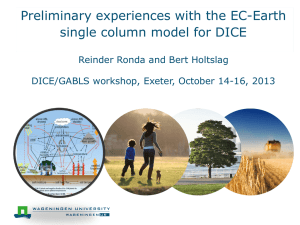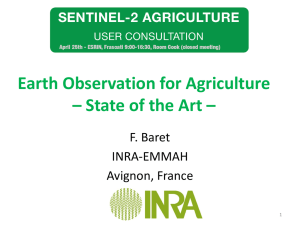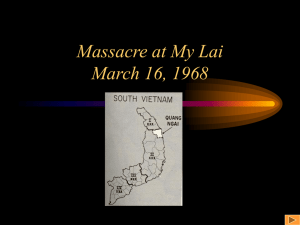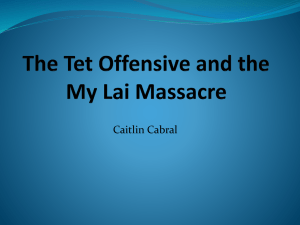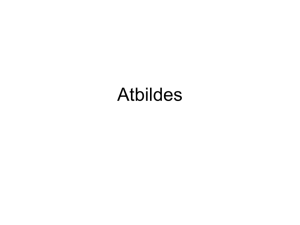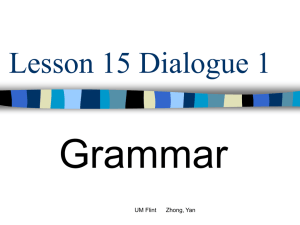1 An empirical expression to relate aerodynamic and surface
advertisement
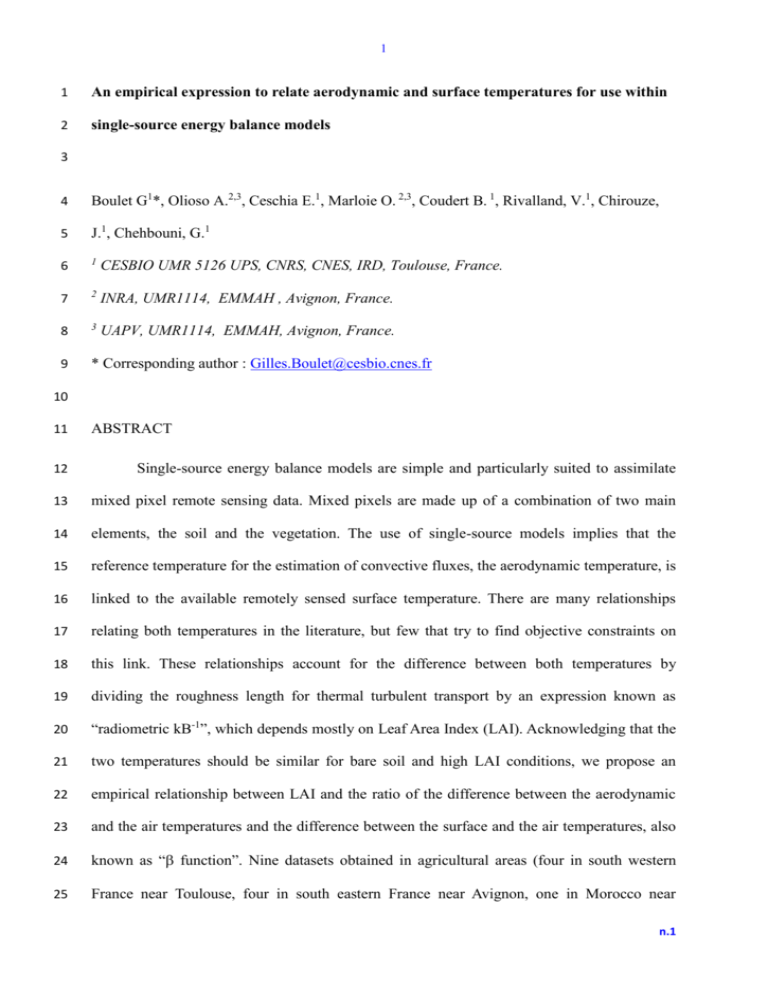
1 1 An empirical expression to relate aerodynamic and surface temperatures for use within 2 single-source energy balance models 3 4 Boulet G1*, Olioso A.2,3, Ceschia E.1, Marloie O. 2,3, Coudert B. 1, Rivalland, V.1, Chirouze, 5 J.1, Chehbouni, G.1 6 1 CESBIO UMR 5126 UPS, CNRS, CNES, IRD, Toulouse, France. 7 2 INRA, UMR1114, EMMAH , Avignon, France. 8 3 UAPV, UMR1114, EMMAH, Avignon, France. 9 * Corresponding author : Gilles.Boulet@cesbio.cnes.fr 10 11 ABSTRACT 12 Single-source energy balance models are simple and particularly suited to assimilate 13 mixed pixel remote sensing data. Mixed pixels are made up of a combination of two main 14 elements, the soil and the vegetation. The use of single-source models implies that the 15 reference temperature for the estimation of convective fluxes, the aerodynamic temperature, is 16 linked to the available remotely sensed surface temperature. There are many relationships 17 relating both temperatures in the literature, but few that try to find objective constraints on 18 this link. These relationships account for the difference between both temperatures by 19 dividing the roughness length for thermal turbulent transport by an expression known as 20 “radiometric kB-1”, which depends mostly on Leaf Area Index (LAI). Acknowledging that the 21 two temperatures should be similar for bare soil and high LAI conditions, we propose an 22 empirical relationship between LAI and the ratio of the difference between the aerodynamic 23 and the air temperatures and the difference between the surface and the air temperatures, also 24 known as “ function”. Nine datasets obtained in agricultural areas (four in south western 25 France near Toulouse, four in south eastern France near Avignon, one in Morocco near n.1 2 26 Marrakech) are used to evaluate this new relationship. They all span the entire cropping 27 season, and LAI values range from 0 to about 5. This new expression of the function is then 28 compared to the function retrieved from measured sensible heat flux and in-situ radiometric 29 measurements as well as the function simulated by a two-source SVAT model (ICARE). Its 30 performance in estimating the sensible heat compares well to other empirical or semi- 31 empirical functions, either based on a function or a radiometric kB-1. 32 33 1. INTRODUCTION 34 Assessing the turbulent fluxes of latent and sensible heat at the land surface is a crucial issue 35 for both water resource management (computation of evapotranspiration) and meteorological 36 forecasting (evolution of the planetary boundary layer). In order to compute these fluxes at a 37 suitable spatial scale, estimation methods based on the use of remote sensing data are 38 favoured. There is a large array of evapotranspiration estimation methods that use as input or 39 constraint remotely sensed variables such as the NDVI (Courault et al., 2005; Gowda et al., 40 2008; Olioso et al., 2005). Evapotranspiration in potential conditions (i.e. not water limited) 41 can be assessed with relatively good precision from in-situ (Cleugh et al., 2007) or remote 42 sensing derived (Venturini et al., 2008) meteorological data, and, very often, NDVI. But when 43 water stress occurs the latent and sensible heat fluxes are more difficult to assess. In those 44 cases, there is a tight coupling between the evapotranspiration and the radiative surface 45 temperature and, consequently, methods based on remote sensing data in the Thermal Infra 46 Red (TIR) domain are favoured (Kalma et al., 2008). Those methods often compute the 47 instantaneous latent heat flux as the residual of the energy budget and, in most cases, an 48 expression of each individual term of the energy budget is proposed (Boulet et al., 2007): 49 Rn G H LE (1) n.2 3 50 While net radiation Rn and, to a lesser extent, soil heat flux G can be expressed directly as a 51 function of the radiative surface temperature, the turbulent fluxes H (sensible heat) and LE 52 (latent heat) depend on a mixed-surface (soil, air and vegetation) temperature source Taero: 53 H c p Taero Tair ra ,h (2) 54 where is the air density, cp the specific heat of air at constant pressure, Tair is the air 55 temperature at a reference level above the canopy and ra,h the aerodynamic resistance for heat 56 exchange. The temperature Taero called aerodynamic temperature represents the average 57 temperature of the air in the vicinity of the vegetation elements within the canopy, at the 58 height of the aerodynamic level (defined as the sum of the displacement height and the 59 roughness length for momentum). There is no measuring device for this temperature, which is 60 usually inverted from turbulent flux measurements. Moreover, it can be significantly different 61 from the ensemble directional radiometric surface temperature Tsurf (as defined by Norman 62 and Becker, 1995) which is usually derived from brightness temperature measurements made 63 by a thermo-radiometer or infrared thermometer at nadir or at a specific view angle (Kustas 64 and Anderson, 2009; Kustas et al., 2007; Stewart et al., 1994) and which is used to assess 65 energy balance from remote sensing data. In general, the relationship between aerodynamic 66 and surface temperatures is obtained through the use of a dual-source energy balance when 67 either the vegetation or the soil bulk skin temperatures are known (Lhomme et al., 2000). 68 Retrieving surface temperature for each of the different components of the surface (mostly 69 soil and plants) is difficult, especially with current remote sensing platforms (Jia et al., 2003). 70 The use of single-source models is therefore favoured over dual-source models to estimate 71 pixel average turbulent fluxes from a mixed-pixel radiometric temperature. For those models, 72 there is a need to develop robust yet simple methods to relate the aerodynamic temperature to 73 the surface temperature. This has been subject of debate for a long time (e.g. see Carlson et n.3 4 74 al., 1995; Kalma and Jupp, 1990). Many formulations exist in the literature, and a 75 comprehensive terminology and conversion formulae are proposed by Matsushima (2005). 76 Historically, most expressions governing the relationship between the aerodynamic and the 77 surface temperatures have been built on an analogy between wind and temperature profiles 78 within the canopy. However, while the bottom boundary condition for wind (a null value at 79 the height of the aerodynamic level) allows defining a roughness length for momentum 80 exchange (zom), the bottom value of the temperature profile, the aerodynamic temperature, is 81 generally unknown. One assumes usually that a roughness length zor (improperly named 82 roughness length for thermal exchange) can be defined so that, at a height corresponding to 83 the displacement height plus zor, the surface temperature of the vegetation can be considered 84 as representative of the aerodynamic temperature. The relationship between both roughness 85 lengths translates into what Matsushima names the “radiometric kB-1” (kB-1radio) which is 86 written as zor zom e kBradio . In that case, the difference between the aerodynamic temperature 87 and the surface temperature in the sensible heat flux formulation is expressed by an additional 88 resistance (Lhomme et al., 1997): 89 H c p 90 zd zd z h where ra ,hm ln h om ku* is the aerodynamic resistance for L L zom 91 heat exchange before kB-1 correction, u* the friction velocity, k the von Karman constant, z the 92 measurement height of the atmospheric forcing, d the displacement height, L the Monin 93 Obhukhov length and h the stability correction function for heat transfer given by Paulson 94 (1970). kB-1radio is derived according to the expected air temperature profile within the canopy 95 and expressed as a function of meteorological data, LAI and plant height. Amongst the well 1 Tsurf Tair 1 radio kB ra ,hm ku H c p ku Tsurf Tair zd zd z h ln h or L L zor (3) n.4 5 96 known formulae, one can cite those from Blümel (Blümel, 1998), Massman (Massman, 1999 97 revisited by Su et al., 2001) and Lhomme (Lhomme et al., 2000). 98 Other authors have proposed a somewhat simpler, and easier to interpret, formulation of the 99 relationship between Tsurf and Taero, called the “ function”, originally proposed by Chehbouni 100 et al. (1997). is expressed solely in terms of the temperatures, independently from wind 101 speed: 102 H c p 103 i.e. 104 105 Even for isothermal surfaces, usually bare soils or very dense canopies, the aerodynamic 106 temperature can be slightly different from the surface temperature, because the diffusion 107 process for heat transfer adds to the convective exchange of air. There is therefore a difference 108 between the effective eddy diffusivities for momentum and heat exchange, which can be again 109 translated into an excess resistance function of an “aerodynamic kB-1” or kB-1aero. The 110 available kB-1 formulae, derived either empirically or from scalar and flux theoretical profiles 111 in the canopy, account for both aspects: the difference between the aerodynamic and the 112 radiometric temperatures (radiometric kB-1) and the difference between momentum and heat 113 exchange diffusion processes (aerodynamic kB-1). For isothermal surfaces, one can expect 114 that there is no radiometric component within the combined (radiometric and aerodynamic) 115 kB-1. The combined kB-1 retrieved for those surfaces from observations by solving for kB-1radio 116 in Eq. 3 is fairly low (within the range 0-5 according to Verhoef et al. 1997, Massman 1999 117 and Yang et al., 2008). For strongly non-isothermal situations, which correspond in general to Tsurf Tair Taero Tair Tsurf Tair ra ,h (4) (5) n.5 6 118 intermediate LAI values (LAI in the range 0.5-2), the combined kB-1 is much higher (in the 119 range 10-30 according to the same authors). One can thus assume that kB-1aero is usually 120 smaller than kB-1radio for all LAI values, or that the difference between the surface temperature 121 and the aerodynamic temperature will have on average a much larger impact on the sensible 122 heat flux than the difference between the diffusion processes for heat and momentum at the 123 vicinity of the canopy. While the radiometric kB-1 do not discriminate between both 124 differences (the difference between the aerodynamic and surface temperatures and the 125 difference between the roughness lengths for momentum zom and heat exchange zoh), the 126 function allows us to separate both aspects and keep the difference between zoh and zom in the 127 1 formulation of the aerodynamic resistance : zoh zom ekBaero and ra,h ra,hm kBaero ku* . 128 Consequently, Eq. 4 can be rewritten as: 129 H c p 130 One must also note that the published values of the radiometric kB-1 (kB-1radio) (Matsushima, 131 2005) according to Lhomme, Blümel and Massman/Su (see formulations in Table 1) can be 132 converted into values by combining equations 3 and 6: 133 1 kBaero ku kB1 ra ,hm radio ku 134 The Blümel and Massman/Su formulations depend on Leaf Area Index LAI through, mostly, 135 the fraction cover (fc) of the canopy and on two parameters difficult to assess, the component 136 aerodynamic kB-1 for bare soil and for vegetation canopy, respectively (See Table 1). Since 137 for bare soil and full cover conditions there is no large difference between both temperatures, 1 Tsurf Tair 1 aero kB ra ,hm ku H c p ku Tsurf Tair zd zd z h ln h oh L L zoh (6) ra ,hm (7) n.6 7 138 the function is fairly easily interpreted: values are close to 1 for those bare soil and full 139 cover conditions, that is, more generally, for all homogeneous isothermal surfaces, while for 140 sparse vegetation decreases. In those conditions, the soil temperature has a large impact on 141 the radiative surface temperature whereas the aerodynamic temperature remains closer to a 142 mix of air and vegetation temperatures and is less influenced by the soil temperature. Since 143 the soil temperature around midday is generally higher than the vegetation temperature, the 144 observed radiative surface temperature is often larger than the aerodynamic temperature 145 around that time. Factors influencing and kB-1radio include LAI and other plant geometrical 146 features such as height and fraction cover, friction velocity, time of the day, solar radiation etc. 147 However, most studies agree on the fact that LAI is by far the main driving factor, at least for 148 agricultural canopies for which the turbid medium (random leaf dispersion, Myneni et al., 149 1989) and permeable-rough transfer hypotheses are valid (Kustas et al., 2007; Verhoef, 1997). 150 This is further confirmed by dual-source land surface models which predict the aerodynamic 151 temperature through the classical dual-source approach (Shuttleworth and Wallace, 1985). 152 The evolution of as a function of LAI is presented in Figure 1a as obtained from an 153 uncalibrated run of the ICARE SVAT model (Gentine et al., 2007) for the B124 wheat site in 154 Morocco (see below). One can observe that the simulated shape of the (LAI) relationship 155 decreases sharply from 1 when LAI increase to about 1, and increases more slowly for higher 156 LAI, tending again to 1 for LAI well above 3. The lognormal distribution function is therefore 157 a good candidate to represent the evolution of 1-(LAI) for the whole range of LAI values. 158 Consequently, we propose the following empirical relationship for : 159 a 1 e LAI * b * 2 160 where a, b and c are empirical coefficients that need to be calibrated. ln(LAI )c 2 2*b2 (8) n.7 8 161 The objectives of the present paper are threefold: 162 1- to retrieve variations with LAI from observations for nine experimental cultural 163 cycles where seasonal evolution of factors governing is available and LAI values 164 range from 0 to well above 2, and by doing so, assess the variability in shapes and 165 scales of the(LAI) relationship, 166 167 168 169 2- to compare several formulae of (LAI), including the new one (Eq. 8; hereafter referred to as the Boulet et al. expression) , against observed trends and 3- to compare the performances of the various formulae in computing sensible heat flux from observed in-situ radiometric surface temperature. 170 The new Boulet et al. expression (Eq. 8) of the function will be first calibrated over the 171 values of derived from experimental data acquired on the B124 wheat site in Morocco (i.e. 172 values will be obtained for a, b and c in Eq. 8). Next, it will be tested on data acquired over 173 eight other crop cycles in South of France. 174 2. STUDY SITES 175 All study sites cover an entire agricultural season, from bare soil to harvest. 176 The first dataset was collected at the B124 site (31.67250°N, 7.59597°W) in the R3 irrigation 177 perimeter in the Haouz semi-arid plain in Morocco during the SudMed project (Chehbouni et 178 al., 2008, Duchemin et al., 2006) in 2004. The climate is semi-arid with an average annual 179 rainfall of the order of 150 mm. The chosen field (number B124) was cultivated with winter 180 wheat and its size (4 ha) exceeded the basic fetch requirements. LAI and vegetation height 181 ranged from 0 in January to 4.5 and 0.8m at maximum development (April), respectively (See 182 Boulet et al., 2007, for more information on this dataset). n.8 9 183 The second dataset was collected over two cultivated plots, Auradé (43°54’97’’N, 184 01°10’61’’E) and Lamasquère (43°49’65’’N, 01°23’79’’E), separated by 12 km and located 185 near Toulouse (South West France). The climate is Mediterranean with an average annual 186 rainfall of the order of 620 mm for both 2006 and 2007, which can be considered as “average” 187 years as far as rainfall is concerned. The Auradé plot was cultivated with winter wheat 188 (Triticum aestivum L., maximum LAI: 3.8, maximum height: 0.68 m) from Oct-2005 to Jun- 189 2006 and with sunflower (Helianthus annuus L., maximum LAI: 2.0, maximum height: 1.27 190 m) from Apr-2007 to Sept-2007. The Lamasquère plot was cultivated with maize (Zea mays 191 L., maximum LAI: 3.3, maximum height: 2.3 m) used for silaging from May-2006 to Aug- 192 2006 and with winter wheat from Oct-2006 to Jul-2007 (maximum LAI: 4.5, maximum 193 height: 0.83 m). This site was irrigated in 2006 when maize was cultivated. For a complete 194 description of the site characteristics, management practices, biomass inventories, vegetation 195 area measurements, instrumentation setup and fluxes calculation procedures see Beziat et al. 196 (2009). 197 The third dataset was acquired on the Avignon 'Flux and Remote Sensing Observation Site', 198 located in Provence, in southeastern France (N 43,92°; E 4,88°; altitude 32 m). The region is 199 also characterized by a typical Mediterranean climate (annual climatic mean of 14° C for 200 temperature and of 680 mm for precipitation). However, during the 2004-2007 period the 201 yearly average for rain was 450 mm with a high variability (313 mm – 745 mm). During the 202 observational period the crop rotation was: Durum Wheat (Triticum durum, maximum LAI: 203 4.0, maximum height: 1.0 m) from January till June 2004, Peas (Pisum sativum, maximum 204 LAI: 2.9, maximum height: 0.43 m) from April till June 2005, Durum Wheat (maximum LAI: 205 5.5, maximum height: 0.75 m) again from November 2005 to June 2006 and Sorghum 206 (Sorghum bicolor, maximum LAI: 3.0, maximum height: 1.16 m) from May to August 2007. 207 Irrigation was applied in particular to the Sorghum and Peas crops. n.9 10 208 All sites were equipped with a tower where standard meteorological forcing data were 209 acquired. Plant height and total (green and dry) Leaf Area Index were measured every month 210 or so by planimetry and hemispherical photography and the resulting values have been 211 interpolated to daily estimates. Half hourly sensible heat fluxes were measured with a 212 Campbell Sci. CSAT3 (B124, Auradé and Lamasquère sites) or a Young 81000 (Avignon site) 213 3D sonic anemometer. Auradé, Lamasquère and Avignon are part of the CarboEurope-IP 214 Regional Experiment (Dolman et al., 2006) and the CarboEurope-IP Ecosystem Component. 215 In that context, the data were used for analyzing CO2 surface – atmosphere exchanges and 216 production for fields with a large interannual rotation of crop types (e.g. Kutsch et al., 2010). 217 For those sites, the Level 3 flux products (i.e. non gapfilled) were used. 218 For all sites, TIR data were acquired with a nadir looking 60° Field Of View Apogee IRTS-P 219 (R3 and SudOuest sites) or an Heitronics KT15 (Avignon site) Infra Red Thermoradiometer 220 and a Kipp and Zonen CNR1 hemispherical pyrgeometer. For the R3 B124 site, the IRTS-P 221 device has been calibrated using an Everest black body during the experiment and prior to the 222 experiment in a laboratory with an adjustable ambient temperature. Retrieved surface 223 temperatures from both instruments showed a bias of 0.21°C and a Root Mean Square 224 Difference of 1.16°C for instantaneous values at midday. Surface temperature estimates from 225 the CNR1 were used for this site. The KT15 instrument in Avignon was calibrated in the 226 laboratory calibration facilities by looking at a black-body at various temperatures. An error 227 analysis of the whole calibration-measurement chain gave an accuracy of 0.4°C. 228 3. PROCEDURE FOR RETRIEVING 229 For all sites, retrieved function values estimated from observations, obs, are derived from 230 measured sensible heat Hobs, surface temperature Tsurf,obs and meteorological data such as air n.10 11 231 temperature Tair,obs that influence the aerodynamic resistance ra,obs calculated using the Monin- 232 Obukhov Similarity Theory: 233 obs 234 where ra,obs is computed using measured friction velocity values. Therefore: 235 ra ,obs H obs c p Tsurf ,obs Tair,obs 1 zd zom e kBa ero zd h h ln 1 kBaero L L zom e obs obs r a ,obs ku,obs (9) (10) 236 Where Lobs is the Monin Obhukhov length estimated from observations and u*,obs the 237 measured friction velocity. 238 In order to assess either (from Eq. 8) or the radiometric kB-1, one would need in theory a 239 full determination of the three main variables: zom, d and zoh=zom/exp(kB-1aero). This is feasible 240 from single-direction radiometric measurements only for bare soil and full cover conditions 241 since in the latter cases aerodynamic and surface temperatures can be considered as identical 242 (kB-1radio=kB-1aero or =1). For all other conditions, zom and zoh can be retrieved from u* and 243 scale temperature T* H c p u* measurements only if Taero is already well known, i.e. if the 244 radiometric kB-1 is known. As a consequence, we decided to use the following expressions 245 from Colaizzi et al. (2004) and Pereira et al. (1999) to compute zom and d: 246 1 e 0.5 LAI d h1 2 LAI 247 zom he 0.5 LAI 1 e 0.5 LAI 248 where h is the vegetation height. (11) (12) n.11 12 249 Given d, one can derive an estimated roughness length zom,obs according to: z d kuobs m u ,obs Lobs 250 z om,obs z d e 251 where uobs is the wind velocity at reference height. We checked that zom values obtained by Eq. 252 12 are valid, i.e. consistent with zom,obs obtained by Eq. 13 (not shown). 253 We choose emissivity values (between 0.96 for a bare soil and 0.98 for a vegetation at full 254 cover) for the computation of surface temperature from brightness temperature measurements 255 and a null value for the aerodynamic kB-1 ( e kBaero 1 ) so that retrieved obsvalues deduced 256 from Eq. 9 tend to one for very high LAI values (and therefore retrieved radiometric kB-1 will 257 be close to zero when solving for kB-1 radio in Eq. 7), which is what is expected for full cover 258 conditions. Values close to zero for the radiometric kB-1 can be found elsewhere in the 259 literature, notably for quasi-bare soils, as suggested both by Massman (1999)(in his paper the 260 radiometric kB-1 tends to 0 when LAI=0 or LAI>>2) and Matsushima (2005) in spite of the 261 large Reynolds numbers encountered in typical agricultural bare soil situations. Of course, 262 overall retrieval results and performances depend strongly on the accuracy of the surface 263 temperature measurements, and this should be investigated further, but it is beyond the scope 264 of this short paper. On the other hand, neglecting kB-1aero also leads to the best performance in 265 estimating sensible heat flux for all LAI values and all sites (not shown) which justifies our 266 choice. Yang et al. (2008) found values of the aerodynamic kB-1 for bare soils between -5 (at 267 night) and 5 (around midday) with an average between 0 and 5 for positive values of observed 268 sensible heat flux. In what follows, obs values are computed for unstable conditions selected 269 on the basis of the following rules: Hobs>0, total incoming solar radiation >10 W/m2 and 270 Tsurf,obs>Tair,obs. Retrieved obs values from Eq. 9 between -1 and 2 are kept since they 271 represent realistic values of the temperature profile within the canopy and the soil/vegetation (13) 1 n.12 13 272 mixed/ensemble contribution (this represents >85% of all Hobs data between 10am and 4pm 273 for the R3 B124 dataset). 274 275 4. RESULTS FOR WHEAT AND OTHER CROPS 276 4.1. Results for the R3 B124 wheat site (calibration of Eq. 8) 277 Median values of the scattered obs values are shown for each 0.5 LAI interval on Figure 1a, 278 together with values simulated by the ICARE dual source SVAT model applied to the R3 279 B124 site without any calibration of ICARE, values interpolated along LAI values from 280 individual estimates proposed by Matsushima (2005) as well as values obtained from Eq. 281 8 (also referred to as “Boulet et al.”), whose a, b and c coefficients are manually adjusted to 282 fit obs values: a=1.7, b=c=0.8. Error bars are shown for observed values by assuming for 283 Eq. 9 an error of 1K on Tsurf,obs, 10% on u*,obs and zom and 10 W/m2 on Hobs. 284 values converted from Eq. 7 based on the three kB-1 expressions proposed by Blümel, 285 Massman/Su and Lhomme are also shown in Figure 1a. 286 For well developed vegetation (say, above LAI=2), all expressions are fairly similar or at least 287 show consistent trends. For sparse and less developed vegetation however (LAI<1, figure 1b, 288 where all single “observed” retrieved values are shown instead of median values), there is a 289 large difference between the Blümel, Massman/Su, Matsushima and Lhomme expressions, on 290 the one hand, and ICARE outputs, the proposed Boulet et al. expression and the observations, 291 on the other hand. Note that ICARE has not been calibrated to the R3 dataset, therefore only 292 the overall shape of the (LAI) relationship is being used to introduce Eq. 8, not its particular 293 scaling/extent properties (a, b and c values) which are derived from obs values. The 294 differences between both groups of estimates could be explained by the fact that for the n.13 14 295 Blümel, Massman/Su and Lhomme expressions, when LAI tends towards 0, the turbulent 296 behavior gives more weight to the aerodynamic kB-1 for a bare soil according to Brutsaert 297 (1982) which tends to underestimate (Yang et al., 2008). As a consequence, the sensible heat 298 flux simulated from the different formulae for using the observed surface temperature 299 (Equation 4), as one would do with remote sensing observations, is closer to the observed 300 sensible heat for the proposed new formula compared to the three previous ones, especially 301 for quasi bare soil (LAI<0.5) conditions. This appears clearly on Figure 2, where the resulting 302 sensible heat flux is estimated by using the various formulae for kB-1 or together with Eqs. 3 303 and 4 respectively are shown. On this figure, the sensible heat flux values away from the 1:1 304 line for the Blümel, Massman/Su, Matsushima and Lhomme expressions correspond to those 305 conditions (LAI<0.5). 306 1 0 for all LAI One must note that if we ignore the correction (i.e. by setting =1 or kBradio 307 values) the root mean square error RMSE between observed and simulated sensible heat 308 fluxes increases from ~50 to ~80 W/m2 for the entire season. This confirms that taking into 309 account the difference between the aerodynamic and the surface temperature is crucial to 310 deriving accurate turbulent heat fluxes. 311 4.2. Results for 8 agricultural seasons in Southern France (validation). 312 The different expressions for are tested for the 3 other sites, i.e. 8 growing seasons and 313 different vegetation and climate conditions. We assume that the adjusted values of the three 314 parameters for the new formulation (a=1.7, b=c=0.8) can provide a good estimate of (LAI) 315 fluctuations for agricultural areas. These values are therefore kept for all sites. Results are 316 shown in Figure 3. Surface temperature is estimated either from the hemispherical (CNR1) or 317 the directional (KT15, IRTS-P) sensors, as specified in the captions. In general, the 318 hemispherical device produces a (LAI) relationship closer to the expected concave-up shape. n.14 15 319 For all sites, the new formulation (Eq. 8) fits fairly well the observed , except for 320 Lamasquère in 2007, which means that the calibrated values for a, b and c at the R3 B124 site 321 are well suited for other sites. For sunflower, corn and sorghum however (Figure 3c, e and f), 322 the trend in (LAI) matches the observed trend but not the observed amplitude, and the value 323 for a should therefore be lower for those cover types. This might be due to the size and shape 324 of the leaves, or to the fact that these canopies show more defined geometrical features (rows, 325 preferred orientation of leaves and flowers…) and are less easily described by turbid medium 326 (for radiation) or permeable-rough interfacial layer (for turbulent transfer) theories. It is also 327 possible to adjust the a, b and c values to fit more closely the observed (LAI) curve. Adjusted 328 values for a range between 1.2 and 1.7, and adjusted values for b and c between 0.5 and 0.8, 329 but do not translate into a significant improvement in computing sensible heat flux. 330 331 Since the primary objective of the formulation is to provide accurate estimates of sensible 332 heat fluxes from observed surface temperature, one needs to assess the resulting performance 333 in using the various models to simulate H. However, it should be noted that the accuracy of 334 those estimates depends primarily on the precision on surface and air temperatures, wind 335 speed, roughness length and the validity of the Monin-Obukhov Similarity Theory. 336 The performance in estimating sensible heat flux for all sites was assessed using the various 337 formulations. Results are shown in Table 2. All formulations perform well for some sites and 338 much less well for others, but the new formulation shows comparable or better performances 339 than the others as indicated by the small number of RMSE values above 60 W/m2 as well as 340 the high number of values under 50 W/m2. The simplicity of this formulation and the fact that 341 it allows tuning at least one parameter (a) to provide realistic values of the difference between 342 the aerodynamic and the surface temperature are two advantages of this formulation. One n.15 16 343 must note that, for both the Blümel and Massman formulations, the poorly known parameters 344 corresponding to the aerodynamic kB-1 for bare soil and full cover (which are found to be 345 close to zero here) can be adjusted as well as the parameter of the exponential decay of the 346 Beer Lambert law used to convert LAI to fraction cover, but in our simulations the results did 347 not prove to be very sensitive to the latter (not shown). Again, all formulations perform well 348 for canopies well described by the turbid medium theory, and less for plants with more 349 defined geometrical features or larger intercropping patterns (Barillot et al., 2011). 350 351 5. CONCLUSION 352 An empirical formulation of the difference between the aerodynamic and surface temperatures 353 as a function of Leaf Area Index has been proposed, which represents in a realistic way the 354 observed variations and leads to satisfactory performance in simulating the sensible heat flux 355 compared to other existing formulations. It should be noted though that the observed 356 variations in this difference were assessed using a null aerodynamic kB-1, based on the fact 357 that the radiometric kB-1 should be close to zero (or close to one) for bare soil and full cover 358 conditions. However, the assumption that the difference between the surface temperature and 359 the aerodynamic temperature will have on average a much larger impact on the sensible heat 360 than the difference between the diffusion processes for heat and momentum at the vicinity of 361 the canopy should be investigated more thoroughly since there is no agreement on what value 362 should be used for the aerodynamic kB-1 for bare soil, intermediate cover and fully covering 363 vegetation, respectively (Verhoef, 1997). In particular, there is no evidence whatsoever that 364 the roughness length for heat exchange should be a constant fraction of the roughness length 365 for momentum for all LAI values, as it is commonly assumed in SVAT models. 366 n.16 17 367 ACKNOWLEDGEMENTS 368 Fundings from the Centre National d'Etudes Spatiales (CNES) for the MiSTIGrI 369 (MicroSatellite for Thermal Infrared Ground surface Imaging) phase A study, the MISTRALS 370 (Mediterranean Integrated STudies at Regional And Local Scales) SICMed (Continental 371 Surfaces and Interfaces in the Mediterranean area) program, and the SIRRIMED (Sustainable 372 use of irrigation water in the Mediterranean Region) European project (FP7 - grant agreement 373 245159), are gratefully acknowledged. Em. Prof. Jetse D. Kalma is also thanked for his very 374 insightful comments on an earlier draft of the manuscript. Avignon and SudOuest data were 375 acquired and processed in the frame of the CARBOEUROPE-IP and the CARBOFRANCE 376 project funded by the European FP7 Program (GOCECT-2003-505572) and the French 377 Ministry in charge of Environment (GICC programme). For the R3 dataset, in addition to 378 IRD, financial support was provided by EC in the frame of the WATERMED project (contract 379 ICA3- CT-1999-00015) and IRRIMED project (contact ICA3-2002-10080) and by the French 380 Programme National de Télédétection Spatiale (PNTS) and the French space agency (CNES). 381 382 REFERENCES 383 384 385 Barillot, R., Louarn, G., Escobar-Gutierrez, A.J., Huynh, P., Combes, D., 2011. How good is the turbid medium-based approach for accounting for light partitioning in contrasted grass-legume intercropping systems ? Ann. Bot., 108(6): 1013-1024. 386 387 Beziat, P., Ceschia, E. and Dedieu, G., 2009. Carbon balance of a three crop succession over two cropland sites in South West France. Agr. For. Met., 149(10): 1628-1645. 388 389 Blümel, K., 1998. Estimation of sensible heat flux from surface temperature wave and onetime-of-day air temperature observation. Boundary-Layer Meteorol., 86(2): 193-232. 390 391 392 Boulet, G., Chehbouni, A., Gentine, P., Duchemin, B., Ezzahar, J. and Hadria, R., 2007. Monitoring water stress using time series of observed to unstressed surface temperature difference. Agr. For. Met., 146(3-4): 159-172. 393 394 Brutsaert, W., 1982. Evaporation into the atmosphere. Environmental fluid mechanics. Kluwer Academic Publishers, Dordrecht / Boston / London, 299 pp. n.17 18 395 396 397 Carlson, T.N., Taconet, O., Vidal, A., Gilles, R.R., Olioso, A. and Humes, K., 1995. an overview of the workshop on thermal remote-sensing held at La-Londe-Les-Maures, France, September 20-24, 1993. Agr. For. Met., 77(3-4): 141-151. 398 399 400 Chehbouni, A., LoSeen, D., Njoku, E.G., Lhomme, J.P., Monteny, B. and Kerr, Y.H., 1997. Estimation of sensible heat flux over sparsely vegetated surfaces. J. Hydrol., 189(1-4): 855-868. 401 402 403 404 405 406 407 408 Chehbouni, A., Escadafal, R., Duchemin, B., Boulet, G., Simonneaux, V., Dedieu, G., Mougenot, B., Khabba, S., Kharrou, H., Maisongrande, P., Merlin, O., Chaponniere, A., Ezzahar, J., Er-Raki, S., Hoedjes, J., Hadria, R., Abourida, A., Cheggour, A., Raibi, F., Boudhar, A., Benhadj, I., Hanich, L., Benkaddour, A., Guemouria, N., Chehbouni, A.H., Lahrouni, A., Olioso, A., Jacob, F., Williams, D.G. and Sobrino, J.A., 2008. An integrated modelling and remote sensing approach for hydrological study in arid and semi-arid regions: the SUDMED programme. Int. J. Remote Sens., 29(17-18): 5161-5181. 409 410 411 Cleugh, H.A., Leuning, R., Mu, Q.Z. and Running, S.W., 2007. Regional evaporation estimates from flux tower and MODIS satellite data. Remote Sens. Environ., 106(3): 285-304. 412 413 414 415 416 Colaizzi, P.D., Evett, S.R., Howell, T.A. and Tolk, J.A., 2004. Comparison of aerodynamic and radiometric surface temperature using precision weighing lysimeters. In: W. Gao and D.R. Shaw (Editors), Remote Sensing and Modeling of Ecosystems for Sustainability. Proceedings of the Society of Photo-Optical Instrumentation Engineers (Spie). Spie-Int Soc Optical Engineering, Bellingham, pp. 215-229. 417 418 419 Courault, D., Seguin, B., Olioso, A., 2005. Review on estimation of evapotranspiration from remote sensing data: From empirical to numerical modeling approaches. Irrig. Drain. Syst., 19(3-4): 223-249. 420 421 422 423 424 425 426 Dolman, A.J., Noilhan, J., Durand, P., Sarrat, C., Brut, A., Piguet, B., Butet, A., Jarosz, N., Brunet, Y., Loustau, D., Lamaud, E., Tolk, L., Ronda, R., Miglietta, F., Gioli, B., Magliulo, V., Esposito, M., Gerbig, C., Korner, S., Glademard, R., Ramonet, M., Ciais, P., Neininger, B., Hutjes, R.W.A., Elbers, J.A., Macatangay, R., Schrems, O., Perez-Landa, G., Sanz, M.J., Scholz, Y., Facon, G., Ceschia, E. and Beziat, P., 2006. The CarboEurope regional experiment strategy. Bull. Am. Meteorol. Soc., 87(10): 1367-1379. 427 428 429 430 431 432 Duchemin, B., Hadria, R., Erraki, S., Boulet, G., Maisongrande, P., Chehbouni, A., Escadafal, R., Ezzahar, J., Hoedjes, J.C.B., Kharrou, M.H., Khabba, S., Mougenot, B., Olioso, A., Rodriguez, J.C., Simonneaux, V., 2006. Monitoring wheat phenology and irrigation in Central Morocco: On the use of relationships between evapotranspiration, crops coefficients, leaf area index and remotely-sensed vegetation indices. Agricultural Water Management, 79(1): 1-27. n.18 19 433 434 Gentine, P., Entekhabi, D., Chehbouni, A., Boulet, G. and Duchemin, B., 2007. Analysis of evaporative fraction diurnal behaviour. Agr. For. Met., 143(1-2): 13-29. 435 436 437 Gowda, P., Chavez, J., Colaizzi, P., Evett, S., Howell, T. and Tolk, J., 2008. ET mapping for agricultural water management: present status and challenges. Irrig. Sci., 26(3): 223237. 438 439 440 Jia, L., Li, Z.L., Menenti, M., Su, Z., Verhoef, W., Wan, Z., 2003. A practical algorithm to infer soil and foliage component temperatures from bi-angular ATSR-2 data. International Journal of Remote Sensing, 24(23): 4739-4760. 441 442 443 Kalma, J.D. and Jupp, D.L.B., 1990. Estimating evaporation from pasture using infrared thermometry: evaluation of a one-layer resistance model. Agr. For. Met., 51(3-4): 223246. 444 445 446 Kalma, J.D., McVicar, T.R. and McCabe, M.F., 2008. Estimating Land Surface Evaporation: A Review of Methods Using Remotely Sensed Surface Temperature Data. Surv. Geophys., 29(4-5): 421-469. 447 448 Kustas, W. and Anderson, M., 2009. Advances in thermal infrared remote sensing for land surface modeling. Agr. For. Met., 149(12): 2071-2081. 449 450 451 Kustas, W.P., Anderson, M.C., Norman, J.M. and Li, F.Q., 2007. Utility of radiometricaerodynamic temperature relations for heat flux estimation. Boundary-Layer Meteorol., 122(1): 167-187. 452 453 454 455 456 457 Kutsch, W.L., Aubinet, M., Buchmann, N., Smith, P., Osborne, B., Eugster, W., Wattenbach, M., Schrumpf, M., Schulze, E.D., Tomelleri, E., Ceschia, E., Bernhofer, C., Beziat, P., Carrara, A., Di Tommasi, P., Grunwald, T., Jones, M., Magliulo, V., Marloie, O., Moureaux, C., Olioso, A., Sanz, M.J., Saunders, M., Sogaard, H. and Ziegler, W., 2010. The net biome production of full crop rotations in Europe. Agriculture Ecosystems & Environment, 139(3): 336-345. 458 459 460 Lhomme, J.P., Chehbouni, A. and Monteny, B., 2000. Sensible heat flux-radiometric surface temperature relationship over sparse vegetation: Parameterizing B-1. Boundary-Layer Meteorol., 97(3): 431-457. 461 462 463 Lhomme, J.P., Troufleau, D., Monteny, B., Chehbouni, A. and Bauduin, S., 1997. Sensible heat flux and radiometric surface temperature over sparse Sahelian vegetation .2. Model for the kB(-1) parameter. J. Hydrol., 189(1-4): 839-854. 464 465 Massman, W.J., 1999. A model study of kB(H)(-1) for vegetated surfaces using 'localized near-field' Lagrangian theory. J. Hydrol., 223(1-2): 27-43. 466 467 468 Matsushima, D., 2005. Relations between aerodynamic parameters of heat transfer and thermal-infrared thermometry in the bulk surface formulation. J. Meteorol. Soc. Japan, 83(3): 373-389. n.19 20 469 470 Myneni, R.B., Ross, J., Asrar, G., 1989. A review on the theory of photon transport in leaf canopies. Agricultural and Forest Meteorology, 45(1-2): 1-153. 471 472 Norman, J.M. and Becker, F., 1995. Terminology in thermal infrared remote-sensing of natural surfaces. Agr. For. Met., 77(3-4): 153-166. 473 474 475 476 Olioso, A., Inoue, Y., Ortega-Farias, S., Demarty, J., Wigneron, J.P., Braud, I., Jacob, F., Lecharpentier, P., Ottlé, C., Calvet, J.C. and Brisson, N., 2005. Future directions for advanced evapotranspiration modeling: Assimilation of remote sensing data into crop simulation models and SVAT models. Irrig. Drain. Sys., 19(3): 377-412. 477 478 Paulson, C.A., 1970. The Mathematical Representation of Wind Speed and Temperature Profiles in the Unstable Atmospheric Surface Layer. J. Appl. Meteorol., 9(6): 857-861. 479 480 Pereira, L.S., Perrier, A., Allen, R.G. and Alves, I., 1999. Evapotranspiration: Concepts and future trends. Irrig. Drain. Syst., 125(2): 45-51. 481 482 Shuttleworth, W.J., and Wallace, J.S., 1985. Evaporation from sparse crops - an energy combination theory. Q. J. R. Meteorol. Soc., 111: 839-855. 483 484 485 Stewart, J.B., Kustas, W.P., Humes, K.S., Nichols, W.D., Moran, M.S. and Debruin, H.A.R., 1994. Sensible heat-flux radiometric surface-temperature relationship for 8 semiarid areas. J. Appl. Meteorol., 33(9): 1110-1117. 486 487 488 Su, Z., Schmugge, T., Kustas, W.P. and Massman, W.J., 2001. An evaluation of two models for estimation of the roughness height for heat transfer between the land surface and the atmosphere. J. Appl. Meteorol., 40(11): 1933-1951. 489 490 491 Venturini, V., Islam, S. and Rodriguez, L., 2008. Estimation of evaporative fraction and evapotranspiration from MODIS products using a complementary based model. Remote Sens. Environ., 112(1): 132-141. 492 493 Verhoef, A., de Bruin, H. A. R., and van den Hurk, B. J. J. M., 1997. Some Practical Notes on the Parameter kB−1 for Sparse Vegetation. J. Appl. Meteorol., 36: 560-572. 494 495 496 Yang, K., Koike, T., Ishikawa, H., Kim, J., Li, X., Liu, H.Z., Liu, S.M., Ma, Y.M. and Wang, J.M., 2008. Turbulent flux transfer over bare-soil surfaces: Characteristics and parameterization. J. Appl. Meteorol. Climatol., 47(1): 276-290. n.20



